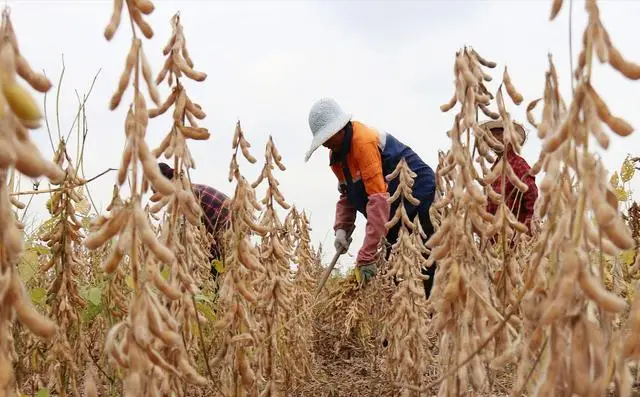Introduction
China offered Brazil an opportunity to sell soybeans, but the Brazilian soybean market has taken the initiative, sending prices to China soaring.
The international soybean market has been volatile recently. On one hand, US soybeans are struggling to sell, facing overflowing warehouses and even fires, and demanding RMB payments.
On the other hand, Brazilian soybeans are readily available, with Chinese buyers scrambling to buy them.
Why are Brazilian farmers choosing to significantly raise prices at this time? And what opportunities are China waiting for as it halts purchases?

As of September this year, China's soybean imports had reached 86.18 million tons, a year-on-year increase of 5.3%.
The structure of China's soybean imports has changed significantly this year. According to US media reports, China has not imported a single shipment of soybeans from the US since May, and purchases have fallen to zero in the second half of the year.
Although US soybean farmers have repeatedly pressured the Trump administration to negotiate with China, the US has only unilaterally demanded that China "buy soybeans," making the negotiations unsuccessful.
In mid-October, a soybean silo in Illinois suddenly collapsed.
US media reports mentioned that a key reason for the collapse was the storage of over 800 tons of soybeans, significantly exceeding previous levels, leading to the collapse.
In contrast, Brazil, previously China's "regular customer," has become China's largest buyer this year. In the first nine months of the year, China imported 69.64 million tons of soybeans from Brazil, accounting for approximately 80% of its total imports.

Due to factors such as sunlight and rainfall, Brazilian soybeans are not as high-quality as US soybeans and are therefore more expensive. This year, thanks to the "patronage" of Chinese customers, Brazilian soybean farmers are experiencing booming business.
Not only that, China has also specifically opened its doors to other agricultural products, such as Brazilian coffee beans, supporting the sale of Brazilian agricultural products subject to US tariffs. However, this situation has recently changed.
The China Soybean Industry Association recently published an article directly pointing out that the current price increase in Brazilian soybeans is "outrageous," causing Chinese customers to halt purchases.
Brazilian soybeans are now $2.8 to $2.9 per bushel higher than November soybeans on the Chicago Board of Trade, and this increase has only recently occurred.
Because Brazil is not only China's largest soybean importer, but now almost its only source,
the impact of Brazil's price increase on China is significant.

Some media outlets even believe that China now has "no choice," and that no other country in the world can meet China's massive import demand.
The sudden price increase in Brazilian soybeans stems from several factors.
First, Chinese buyers have not yet placed orders for new US soybeans, and this temporary supply-demand gap has been accurately capitalized on by some Brazilian exporters. With the global soybean export market highly concentrated in a few countries, such as Brazil and the United States, Brazilian exporters have exploited their short-term advantage as China's core supplier to reap excess profits by raising their bids, creating a typical "seller's market" short-term premium.
In other words, this premium is essentially a speculative attempt to fill short-term supply gaps amidst shifting trade patterns.
This is undoubtedly a price-raising operation that exploits China's limited import channels.
Another factor lies in the "rules."

Currently, the Chicago Board of Trade (CBOT) soybean contract price serves as the benchmark, with premiums and discounts added to determine the final import price. This has long concentrated pricing power in the hands of the international futures market and multinational grain traders.
This has led to China's trade position being very passive:
Despite being the world's largest soybean importer, with annual imports accounting for over 60% of global trade, it lacks control over the pricing system and can only passively accept the results of the benchmark price combined with regional premiums and discounts.
And Brazilian exporters further amplify these regional premiums and discounts. Under this pricing mechanism, suppliers hold the initiative in adjusting premiums and discounts, significantly impacting China.
In addition to these factors, foreign media recently predicted rising Brazilian soybean prices due to a lack of diversified imports.
China's annual soybean consumption is approximately 110 million tons, while domestic production is only around 20 million tons, with over 80% relying on imports.

Although China has made advance preparations over the years, due to the limited number of soybean-growing countries worldwide, it cannot import soybeans through multiple channels, as it does with oil and natural gas.
This long-term rigid demand has limited China's bargaining power in the international soybean trade. Brazil, as a core supplier, has capitalized on this rigid demand to launch a price offensive.
At the same time, China's diversified import system has been under trial and error for several years.
For reference, by 2024, Argentina, Uruguay, and other source countries combined accounted for only 7%. It is difficult to replace Brazil's supply in the short term, further strengthening Brazil's pricing advantage.
Combining these factors, it is not difficult to understand the significance of Brazil's recent price increases. Chinese soybean traders are collectively halting imports, anticipating two key milestones.
First, Brazil's domestic soybean supply far exceeds demand, and China is the largest buyer. If China doesn't buy, Brazil will soon face an oversupply of soybeans.

The Brazilian National Supply Company predicts that soybean production will reach a record 177.6 million tons in the 2025/26 fiscal year, with export potential reaching 110 million tons.
New soybeans will begin shipping to China at the end of January of the following year. The increased supply from the bumper harvest will fundamentally ease short-term tensions, forcing them to lower prices.
Second, awaiting a breakthrough in Sino-US trade negotiations, Brazilian soybean prices could face a significant decline.
Despite the current tensions in Sino-US trade relations, communication channels have not been completely closed.
In 2024, China will still import 22.13 million tons of soybeans from the United States, a significant supply capacity that cannot be underestimated.
If a breakthrough is achieved in the negotiations, Chinese buyers could turn to more attractively priced US soybeans, effectively constraining Brazilian soybean prices.
If panicked Chinese buyers repurchase US soybeans, Brazilian soybean farmers will inevitably rush to sell, causing prices to fall.
This massive price increase in Brazilian soybeans has also taught Chinese importers a lesson: the importance of finding a fundamental solution to the soybean problem and balancing the market.
China's strategic soybean reserves have been fully stockpiled in recent years. If market supply becomes tight, releasing reserves can quickly stabilize prices and fully meet near-term consumer demand. This is one of the "emergency" measures.
Furthermore, we must break free from the trap of relying on a single product. In addition to Brazil, China is also expanding its stable soybean import sources from countries such as Argentina, Uruguay, and Canada.
At the same time, China is also working to advance the technology of replacing soybean meal with miscellaneous meal, such as rapeseed meal and cottonseed meal, in the feed protein sector to address the bottleneck of foreign soybean supply. This is an effective way to address this challenge.

%20--%3e%3c!DOCTYPE%20svg%20PUBLIC%20'-//W3C//DTD%20SVG%201.1//EN'%20'http://www.w3.org/Graphics/SVG/1.1/DTD/svg11.dtd'%3e%3csvg%20version='1.1'%20id='图层_1'%20xmlns='http://www.w3.org/2000/svg'%20xmlns:xlink='http://www.w3.org/1999/xlink'%20x='0px'%20y='0px'%20width='256px'%20height='256px'%20viewBox='0%200%20256%20256'%20enable-background='new%200%200%20256%20256'%20xml:space='preserve'%3e%3cpath%20fill='%23FFFFFF'%20d='M194.597,24.009h35.292l-77.094,88.082l90.697,119.881h-71.021l-55.607-72.668L53.229,232.01H17.92%20l82.469-94.227L13.349,24.009h72.813l50.286,66.45l58.148-66.469V24.009z%20M182.217,210.889h19.566L75.538,44.014H54.583%20L182.217,210.889z'/%3e%3c/svg%3e)




